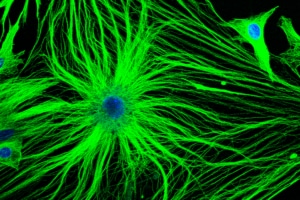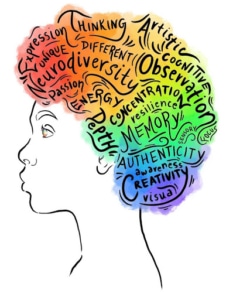DCPA NEWS CENTER
Enjoy the best stories and perspectives from the theatre world today.
Enjoy the best stories and perspectives from the theatre world today.
You have your very own theater production, being acted out right now, in your brain. An exquisitely complex organ, driven by the hard work of both the actors onstage (your nerve cells) and the players behind the scenes (your glial cells).

Glial cells. Photo courtesy of Quanta Magazine
Just like in an immersive play, your nerve cells steal the show. They communicate and interact with each other and the audience. They have subtle and explosive powers. But they can’t do it on their own. Quietly making it all happen behind-the-scenes, from the stage hands to lighting, director to box office staff, are your glial cells. These are a special type of brain cell, smaller than the neurons acting out the play, but far more numerous, and making sure the whole thing runs smoothly. They protect your neurons, regulate your nerve activity, aid in repair and help new nerve cells grow. These behind-the-scenes wonders keep those high-test brain cells firing away.

Photo courtesy of Mighty Well
The purpose of all this firing? It allows you to make sense of information coming from within you and all around you. You have over 100 billion cells monitoring the status of your body and the environment in which it sits. Cues come in, the brain processes it, integrates it, and then decides which behaviors, words and actions are needed. In fact, at this very moment, your brain is doing just that. You are taking in these words, integrating them into your idea of yourself, and possibly even igniting a deeper want to know more.
Which brings us to neuroscience, the study of the nervous system. There are neuroscientists who research how this amazing system develops in the womb. There are others who seek to understand how and why it degenerates as we age. Neuroanatomists study brain structure, and along with colleagues from the world of chemistry and molecular biology, examine the connection between brain structure to brain function. And here’s what they found. Just as no two performances of the DCPA’s new immersive production, Theater of the Mind, are alike, neither are two brains. This phenomenon is called neurodiversity.

Some of the creative team for Off-Center’s ‘Theater of the Mind,’ created by David Byrne and Mala Gaonkar. Photo by Adams VisCom.
Neurodiversity means that you, friend, are one-of-a-kind. It’s not only a huge leap in personalized medicine, but is also helping to remove the stigma associated with the dogma of normal vs not normal, especially in mental health. That’s right, there is no such thing as normal. Rather, there is a wide range of perfectly healthy variation in both brain structure and function.
In this way, neuroscience and neurodiversity beautifully mirror the question, “What is art?” Creators, like those behind Theater of the Mind, push the boundaries of what a theater experience can be. Just as neuroscientists continue to explore the intricacies and power of the brain. Both leverage innovative experimentation and seek to divine a deeper understanding of the human experience. Perhaps then, the analogy of neuroscience to theater isn’t so much an analogy at all, but a colleague, as we all strive to better make sense of ourselves and our place in the world.
